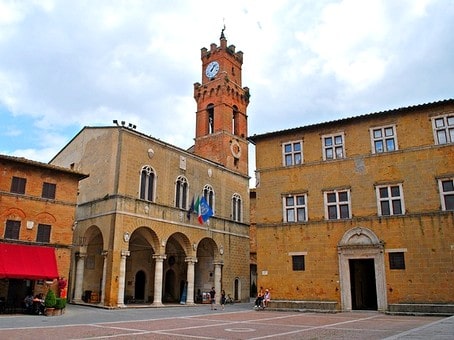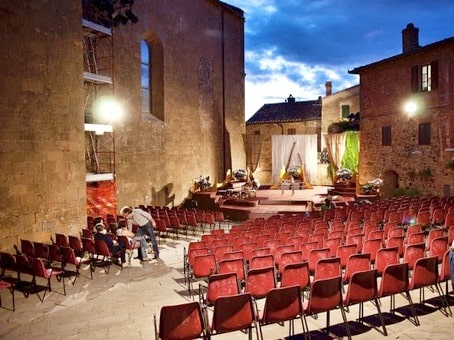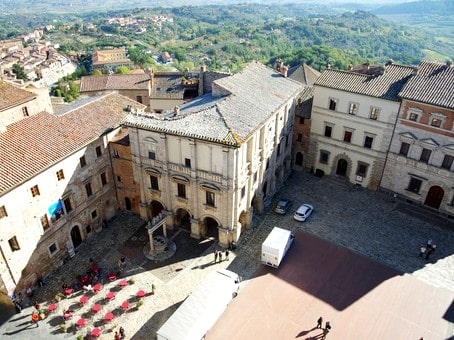Visit Monticchiello: the Poor Theater

 guided tour tuscany
guided tour tuscany
Monticchiello: visit of the village
In the heart of the Val d'Orcia, close to the little towns of
Pienza and Montepulciano, you can visit the ancient medieval
hamlet of Monticchiello. A typical Tuscan village... graceful,
with austere beauty, located on the top of a hill, which was
like a connection place between the centers and communities of
the area, during the Etruscan and Roman times
Visiting Monticchiello allows you to better understand its
strategic position: it was the bulwark of a defensive system of
the Republic of Siena, as evidenced by the walls and the tower
of the keep, which stands on the hill.
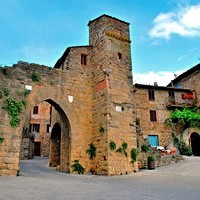
The history of Monticchiello
the hamlet of the Poor TheaterWalking through the narrow streets of the medieval village, you will have the sensation of visiting a place out of time (the first settlement dates back to the 10th century). The "recent" history of Monticchiello begins with the passage under the protection of the city of Siena even if, in reality, its name is traced back to the Roman gens Clelia. The white plaque affixed above the entrance door to the medieval village (Porta Sant'Agata), bears the date of 1213, the period in which the village assumed its present form. With the fall of the Sienese Republic in 1559, Monticchiello was annexed to the Medici's Florentine domain.
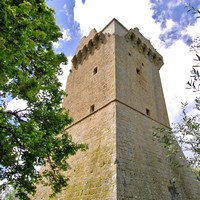
The keep and the walls
visit the historic centerVisiting Monticchiello has always meant walking slowly through winding, well-kept and shaded alleys, encountering -occasionally - the vestiges of a solid system of fortifications, consisting of the Rocca (located at the highest point of the hill) and the turreted walls, which protected the medieval village. Of the fortress remains only the imposing tower, built by following the Sienese architecture. The walls, partially preserved, are interspersed with little towers of various shapes and sizes, of which we can count only seven: five with a square-base and two round-base.
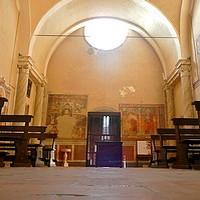
S. Leonardo - S. Cristoforo
the provost churchThe walls of Monticchiello date back to the 13th century, when the provost church of San Leonardo and San Cristoforo was erectedand it worth an internal visit during your walk. The church was built in a Gothic style, with a very simple facade, a beautiful ogival portal and an elegant rose window. The interior has a single nave and preserves some interesting frescoes from the Sienese school, dating back to the fourteenth and fifteenth centuries. Among all, a colossal fresco of San Cristoforo stands out in the presbytery. In one day, you can visit not only Monticchiello but also some surrounding little places in the area.
VISIT THE VILLAGE: TRADITIONS
The poor Theater of Monticchiello
The Poor Theater of Monticchiello was started in the 1960s as a
form of resistance to the economic crisis linked to the
sharecropping. A cultural and social project was born from
below, from the poor and common people: the villagers who
remained in the hamlet gathered around an idea of a "theater in
the square" as like as a greek theater. The shows are a
cross-section of the bourgeois vicissitudes and, for more than
50 years, during the winter time, the inhabitants spend their
free time by writing the screenplay, the texts and they continue
to rehearse. But when summer arrives, the villagers will
transform the square into a real "poor theater”, building the
sets and thestaging the open-air show.
The shows are a collective work of the people of Monticchiello,
they are a clear example of participatory theater, which has
fascinated personalities such as Fellini, Strehler, Sordi,
Ronconi and many others. Perhaps this is the reason why the Poor
Theater attracts 4,000 Italian and foreign spectators every
summer and it's studied by sociologists and anthropologists from
all over the world: an innovative form of art, unique in quality
and longevity. Visit Monticchiello, it will surprise you!
A GUIDE TO DISCOVER THE TERRITORY
The area of Monticchiello
Pienza, city of Pope Pius II
Pienza is a small village built in the nearest of Monticchiello but, definitely, will worth a visit. The town enjoys a strategic position, perched on the top of a hill overlooking the entire Val d'Orcia. It is known as the "ideal" city of the Renaissance, created by the great humanist Enea Silvio Piccolomini, who later became Pope Pius II, who transformed his native place (Corsignano) into a utopian city: it should have embodied the principles and philosophy of Classical and Renaissance ages: Pienza.
Visit San Quirico d'Orcia
Along the Via Francigena road, an important pilgrimage route from Canterbury to Rome, you'll pass through the village of San Quirico d’Orcia which, even today, retains all its medieval characteristics. The pretty town became one of the historical resting place for the middle ages' travelers. We'll suggest to have a break of half day in order to enjoy San Quirico d'Orcia. A little village with a precious Romanesque Church: The Collegiate of San Quirico. You'll be estonished in front of its imposing main portal enriched with zoomorphic sculptures and then in the Horti Leonini, an exemplary model of a Renaissance's garden. A wonderful place where to taste the typical tuscan plates!
Montepulciano: the "Nobile"
Montepulciano is a medieval town of rare beauty to visit: the elegant Renaissance palaces, the ancient churches, the splendid squares and the small hidden corners. The enchanting location of the town of Montepulciano makes it an ideal place to set out to discover this beautiful corner of Tuscany, to visit the neighboring villages or the splendid Val d'Orcia. Having become the scenographic fifth of many films, Montepulciano is famous - among other things - for its “Vino Nobile”. The best place to relax, to get a food&drink experience, to hiking, to walk and... to enjoy the calm and the views.
Book your tourist guide, discover Tuscany
Choose the competence and access to our services
